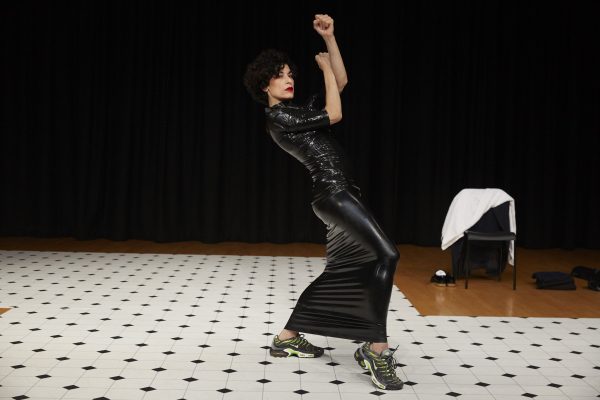
Culture Critic Maddi Simpson reviews Alexandra Bachzetis’ contribution to this years Fierce Festival which challenges the very medium of choreography and performance
Alexandra Bachzetsis’ performance art piece ‘Private: Please Wear a Mask When You Talk To Me’ is a multi-media and multi-modal exploration into the ritualisation of gender and sexuality. The show made its UK premiere on the 20th of October 2019, as a part of the LGBT+ arts festival ‘Fierce’, a West Midlands based arts festival which spotlights queer artistry from the UK and across the globe.
“Private manages to question the nature of culture’s influence on bodily individuality and sexuality, whilst also maintaining a sense of humour and parody
Bachzetsis is a Swiss choreographer, dancer and visual artist and ‘Private’ as a piece conflates dance, the visual arts and theatre into one act. The 50-minute-long choreographed performance art welds facets of popular culture together; such as hip-hop, films and the burlesque style strip-tease that coalesce into a performance which borders on the parodic, and yet also encourages dialogue between the relationship of the body and performativity. In Bachzetsis’ performance, the body is utilised as an apparatus in which different critical and artistic frameworks can be explored through. The body is the most central component to Bachzetsis’ performance, and this is achieved through the various styles of bodily movement that Bachzetsis uses throughout. Dance movements instantly recognisable from 2000s hip hop music videos is mixed with more traditional ballroom type movement, to the occasional insertion of push ups and typical work out bodily movement that is almost reminiscent to the infamous John Travolta and Jamie Lee Curtis workout scene from the 1985 film ‘Perfect’. This melding of different frameworks of art and bodily choreography in reference to contemporary popular culture is used to highlight the ways in which the body is continually created and re-created continuously at the intersection between individuality and cultural definitions of individuality.
The body and how it is created and mediated through culture is questioned frequently throughout the breadth of Bachzetsis’ work, but ‘Private’ manages to question the nature of culture’s influence on bodily individuality and sexuality, whilst also maintaining a sense of humour and parody that keeps the audience member enwrapped into the narrative of Bachzetsis’ performance.
It is worth noting that this performance was in part curated by philosopher, theorist and author Paul B. Preciado, who specialises in theory regarding the body, gender theory and performance. One of Preciado’s central ideas is that the body is regulated through a series of social and cultural phenomena, namely the intersection between pornography and pharmacology (labelled by Preciado as the pharmopornographic) as the ways in which the body is created and re-created through media (pornography) and the scientific and heavily capitalistic (social) nature of pharmacology. This idea of mediation and re-mediation is again a central component to Bachzetsis’ performance. Media, particularly contemporary popular media is shown by Bachzetsis’ as a tool which configures the body, and which representation of gendered expression in media helps to configure oneself to a presupposed set of Western cultural ideals.

There are several noteworthy moments in ‘Private’ which contribute to the performance’s overall thematic qualities. At the very beginning, Bachzetsis descends from the top of the audience to the stage in a skin-tight floor length PVC dress, worn with neon sports trainers, as M.I.A’s 2010 track ‘Bad Girls’ rings through the studio. After standing in the middle of the stage for a few moments, she asks an audience member to spray her with canned water, which then gives her dress a slicked look; less burlesque and more high-fashion bin bag. With red lipstick and curled styled hair, Bachzetsis begins by moving her body with sensuality. As the performance progresses, Bachzetsis then removes this dress and replaces it with a series of layered gym attire. Sections of this performance are dedicated to the application and removal of clothes, often with no musical accompaniment, so the subtle sounds of fabric against skin can be heard throughout the room. The act of dressing and un-dressing fits into the performance’s focus upon the different rituals of the body, as different clothes are socially used as different modes of gendered and sexual expression, the process of removing and re-applying clothes highlights how the body and its gendered expression is created through media.
The ritualization of gender and sexuality becomes more prominent in the second half of the performance, when whilst wearing a navy-blue suit and black boots, Bachzetsis then begins a repetitive choreographed routine, that includes slapping her feet, clicking, the occasional shimming of the hips and throwing her legs in the air. This intensely repetitive section is used to physical replicate the process of bodily ritualization.
“The ritualization of gender and sexuality becomes more prominent in the second half
After the repetitive choreographed sequence, Bachzetsis then plunges her head into a bucket of water, drenching her upper body. In the very final moments of the piece, Bachzetsis is sat on a chair with a microphone attached. She brushes her hair, and the subtle sounds of comb running through wet hair can be faintly heard in the studio. Bachzetsis then begins to sing in Italian in an operatic style of singing, and this is the only moment in which Bachzetsis uses her voice. The use of singing here is used to represent a mode for agency and survival, the voice is employed as a sharp contrast to the use of failing and tiresome naturalized gendered codes used repeatedly throughout the performance.
The multi-modal form of performance art that Bachzetsis has created effectively demonstrates through her physicality, the ways in which the body is endlessly created and re-created through the mediation of popular culture, and how gender, sexuality and identity can be fabricated through repetitive and ritualised bodily gestures and movement, and can be broken through voice.
Comments